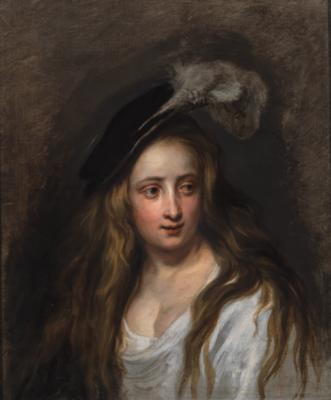School of Antwerp, 17th Century

A young woman wearing a feathered cap,
oil on canvas, 65 x 54 cm, framed
Provenance:
sale, Pandolfini, Rome, 3 March 2020, lot 151;
Private collection, United Kingdom
The present, arrestingly beautiful portrayal of a young lady is a tronie, an outstanding example of the Antwerp School’s manner of recording heads that could then be re-used in larger history compositions. The handling of the work, from the delicate white impastos on the lower eyelids which imbues them with a suggestion of wetness and melancholy, to the painterly brio with which the woman’s flowing hair is rendered, suggests an accomplished hand in the orbit of both Peter Paul Rubens (1577–1640), and Rubens’s ‘most gifted pupil’ Anthony van Dyck (1599–1641). A possible preparatory drawing for the present work, formerly attributed to the third of the great triumvirate of Antwerp masters, Jacob Jordaens (1593–1678) is conserved in the Kupferstich-Kabinett, Dresden (inv. no. C. 19290-144). However, the authorship of both the Dresden drawing and the present work remain open art historical questions.
The present tronie appears also to have been employed for the female figure in a Shepherd and Shepherdess work conserved in the Graf von Schönborn collection at Pommersfelden, formerly given to the Rubens pupil Jan van den Hoecke (see W. Schonath and Max H. von Freeden, 250 Jahre Schloss Pommersfelden (1718–1968), Würzburg, 1968 p. 164, no. 351). Both that work and the present canvas can be placed within a pastoral Antwerp sub-genre of mythological shepherds and shepherdesses which was first developed by van Dyck when the master depicted the characters Amaryllis and Mirtillo, taken from Ferrarese writer Giovanni Battista Guarini’s 1590 tragicomedy il Pastor Fido. An attribution of the present tronie to Jan Cossiers (1600–1671), who was likely similarly active in Rubens’s workshop, has also been suggested.
We are grateful to Bert Schepers of the Centrum Rubenianum, Antwerp for connecting the present lot to the painting in Pommersfelden and the drawing in Dresden and for his assistance in cataloguing the present lot.
Esperto: Damian Brenninkmeyer
 Damian Brenninkmeyer
Damian Brenninkmeyer
+43 1 515 60 403
old.masters@dorotheum.com
09.11.2022 - 17:00
- Prezzo realizzato: **
-
EUR 97.562,-
- Stima:
-
EUR 80.000,- a EUR 120.000,-
School of Antwerp, 17th Century
A young woman wearing a feathered cap,
oil on canvas, 65 x 54 cm, framed
Provenance:
sale, Pandolfini, Rome, 3 March 2020, lot 151;
Private collection, United Kingdom
The present, arrestingly beautiful portrayal of a young lady is a tronie, an outstanding example of the Antwerp School’s manner of recording heads that could then be re-used in larger history compositions. The handling of the work, from the delicate white impastos on the lower eyelids which imbues them with a suggestion of wetness and melancholy, to the painterly brio with which the woman’s flowing hair is rendered, suggests an accomplished hand in the orbit of both Peter Paul Rubens (1577–1640), and Rubens’s ‘most gifted pupil’ Anthony van Dyck (1599–1641). A possible preparatory drawing for the present work, formerly attributed to the third of the great triumvirate of Antwerp masters, Jacob Jordaens (1593–1678) is conserved in the Kupferstich-Kabinett, Dresden (inv. no. C. 19290-144). However, the authorship of both the Dresden drawing and the present work remain open art historical questions.
The present tronie appears also to have been employed for the female figure in a Shepherd and Shepherdess work conserved in the Graf von Schönborn collection at Pommersfelden, formerly given to the Rubens pupil Jan van den Hoecke (see W. Schonath and Max H. von Freeden, 250 Jahre Schloss Pommersfelden (1718–1968), Würzburg, 1968 p. 164, no. 351). Both that work and the present canvas can be placed within a pastoral Antwerp sub-genre of mythological shepherds and shepherdesses which was first developed by van Dyck when the master depicted the characters Amaryllis and Mirtillo, taken from Ferrarese writer Giovanni Battista Guarini’s 1590 tragicomedy il Pastor Fido. An attribution of the present tronie to Jan Cossiers (1600–1671), who was likely similarly active in Rubens’s workshop, has also been suggested.
We are grateful to Bert Schepers of the Centrum Rubenianum, Antwerp for connecting the present lot to the painting in Pommersfelden and the drawing in Dresden and for his assistance in cataloguing the present lot.
Esperto: Damian Brenninkmeyer
 Damian Brenninkmeyer
Damian Brenninkmeyer
+43 1 515 60 403
old.masters@dorotheum.com
|
Hotline dell'acquirente
lun-ven: 10.00 - 17.00
old.masters@dorotheum.at +43 1 515 60 403 |
| Asta: | Dipinti antichi I |
| Tipo d'asta: | Asta in sala con Live Bidding |
| Data: | 09.11.2022 - 17:00 |
| Luogo dell'asta: | Wien | Palais Dorotheum |
| Esposizione: | 22.10. - 09.11.2022 |
** Prezzo d’acquisto comprensivo dei diritti d’asta acquirente e IVA(Paese di consegna Austria)
Non è più possibile effettuare un ordine di acquisto su Internet. L'asta è in preparazione o è già stata eseguita.
